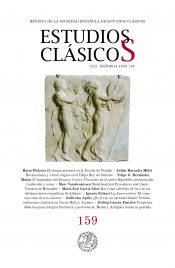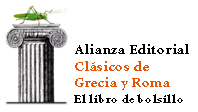ΚΑΙ COMO ADVERBIO DE FOCO EN LAS DECLAMACIONES ETOPOÉTICAS DE LIBANIOΚαί as additive focus adverb in the ethopoietic declamations of Libanius
María José García Soler
Resumen
Resumen. La partícula καί se usa principalmente como conjunción coordinante copulativa, pero puede realizar también la función de adverbio de foco. Dentro de los diversos tipos que existen, καί se sitúa en la categoría de los adverbios de inclusión o aditivos, que indican que el elemento que focalizan, al que el hablante da mayor relevancia informativa, se añade al conjunto formado por otros valores posibles (las alternativas) a los que la proposición es igualmente aplicable. Dependiendo del contexto, es un equivalente aproximado de también, en una adición neutra, y de incluso, cuando en una escala que mide la adición focaliza el elemento menos esperable o que va en contra de las expectativas del hablante. El propósito de este artículo es estudiar la tipología de los elementos que pueden ser focalizados con καί y sus propiedades desde los puntos de vista semántico, sintáctico y pragmático, tomando como base el corpus formado por las declamaciones etopoéticas de Libanio de Antioquía.
Palabras clave:
Abstract
Abstract. Particle καί is mainly used as a copulative coordinating conjunction, but it can also function as an additive focus adverb. Among the various types that exist, καί belongs to the category of inclusion or additive adverbs, which indicate that the element they focus on, to which the speaker gives greater informative relevance, is added to the set formed by other possible values (the alternatives) to which the proposition is equally applicable. Depending on the context, it is a approximate equivalent of also, in a neutral addition, and of even, when on a scale that measures the addition, it focuses on the least expected element or that goes against the expectations of the speaker. The purpose of this paper is to study the typology of the elements that can be focused by καί and the properties of the particle from the semantic, syntactic and pragmatic points of view, based on the corpus composed by the Libanius of Antioch’ ethopoietic declamations.
Keywords:
Referencias bibliográficas
Conti, L. (2015) «Zu den Fokusadverbien bei Homer: Analyse von ἔτι», HSF 127, 208-227, doi: 10.13109/hisp.2014.127.1.208.
Crespo, E. (2015) «Adverbios de foco en griego clásico», en J. Vela Tejada; J.F. Fraile Vicente & C. Sánchez Mañas (eds.) Studia Classica Caesaraugustana. Vigencia y presencia del mundo clásico hoy: XXV años de Estudios Clásicos en la Universidad de Zaragoza, Zaragoza, Prensas de la Universidad de Zaragoza, 207-233.
Crespo, E. (2017): «Focus adverbs in Classical Greek», en P. Poccetti & F. Logozzo (eds.) Ancient Greek Linguistics: New Approaches, Insights, Perspectives, Berlin/Boston, de Gruyter, 133-154, doi: 10.1515/9783110551754-145.
Crespo, E.; Conti, L. & Maquieira, H. (2003) Sintaxis del griego clásico, Madrid, Gredos.
Denniston, J.D. (19542) The Greek Particles, Oxford, Clarendon Press.
Jiménez Delgado, J.M. (2016a) «Categorías tradicionales y pragmática: καί estructural», Synthesis 23, e004.
Jiménez Delgado, J.M. (2016b) «Concessive participles and epitactic constructions in Ancient Greek», JGL 16, 181-201, doi: https://doi.org/10.1163/15699846-01602002.
Jiménez Delgado, J.M. (2017): «Ancient Greek καί: marginal adverbial uses», en P. Poccetti & F. Logozzo (eds.) Ancient Greek Linguistics: New Approaches, Insights, Perspectives, Berlin/Boston, de Gruyter, 171-180, doi: 10.1515/9783110551754-183.
König, E. (1988) «Concessive connectives and concessive sentences: Cross-linguistic regularities and pragmatic principles», en J.A. Hawkins (ed.) Explaining Language Universals, Oxford, Blackwell, 145-166.
König, E. (1991) The Meaning of Focus Particles: A Comparative Perspective, Londres/Nueva York, Routledge.
Lejeune, M. (1960) «Hittite kati-, grec κασι-», BSL 55, 20-26.
Maquieira, H. (2015) «Caracterización funcional del adverbio ἔτι en los oradores y Platón», Myrtia 30, 185-206.
Maquieira, H. (2017) «Algunos adverbios de inclusión y de ‘escala’ en los oradores», en I. Hajnal; D. Kölligan & K. Zipser (eds.) Miscellanea Indogermanica, Festschrift für José Luis García Ramón zum 65. Geburtstag, Innsbruck, Innsbrucker Beiträge zur Sprachwissenschaft, 433-442.
Martínez, R. (2014) «Adverbios de foco en griego antiguo: μόνον frente a μόνος en la prosa historiográfica clásica y helenística», CFC(egi) 24, 17-37, doi: http://dx.doi.org/10.5209/rev_CFCG.2014.v24.44719.
Redondo, E. (2015) «Adverbios de foco y marcadores discursivos: el griego σχεδόν en la novela griega antigua», Minerva 28, 163-183.
Romero Criado, A. (2019) «Los valores del adverbio καί en el Nuevo Testamento. Clasificación semántica», Fortunatae 30, 143-158, doi: https://doi.org/10.25145/j.fortunat.2019.30.09.
Ruijgh, C.J. (1967) Études sur la grammaire et le vocabulaire du grec Mycénien, Ámsterdam, Adolf M. Hakkert.
Wakker, G.C. (1994) Conditions and Conditionals: An Investigation of Ancient Greek, Ámsterdam, J.C. Gieben.
Wathelet, P. (1964) «Mycénien et Grec d᾽Homère. 2 La particule καί», AC 33, 10-44.
Revista
-
Sobre la revista
Página principal
-
Estatutos
Estatutos de la Revista Estudios Clásicos
-
Código ético
Declaración de buenas prácticas
-
Normas de recepción y envío
Indicaciones para envíos de artículos
-
Equipo editorial
Consejos de redacción y asesor
-
Comité de honor
Comité de honor
Información
-
Para autores
Publicar con nosotros
-
Para evaluadores
Normas para evaluar artículos
-
Para bibliotecas
Información bibliográfica
-
Contacto
Cuestiones y preguntas
Publicar en EClás
-
Envío de originales
Artículos y reseñas
-
Normas de publicación
Descarga normas en PDF
-
Estilo CSL EClás
Estilo CSL EClás
-
Índices de calidad
Bases de datos e impactos


 c/ Serrano, 107
c/ Serrano, 107